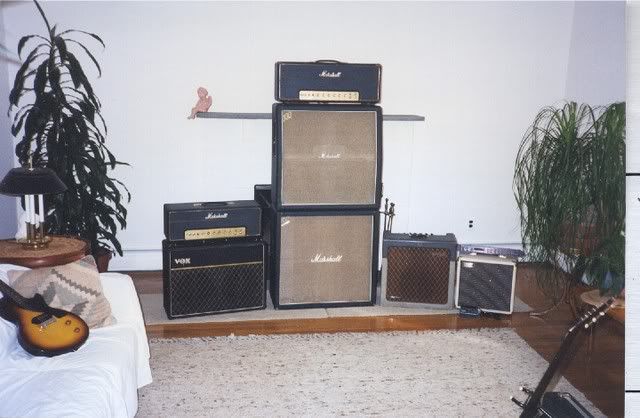


Moderators: VelvetGeorge, BUG



Thats why we rely on you, Jim!! You've got this shit down to a science!!Scumback Speakers wrote:Fun, ain't it?
Danger, Will Robinson. Voice coil rub is the beginning of the end. You should send that to Chris ****** to be fixed. He's got the tools/chemicals/knowhow to save that original cone & coil if it's not too bad. I've referred him a good 10-12 clients over the years, and they all say their speakers sounded great after getting them back from him.the boogie man wrote:Oh I see, that makes a lot of sense, thank you. I noticed it has a little coil rub, but it doesn't seem to affect the sound any.
Scumback Speakers wrote:Danger, Will Robinson.
Thanks for the advice!Scumback Speakers wrote:Danger, Will Robinson. Voice coil rub is the beginning of the end. You should send that to Chris ****** to be fixed. He's got the tools/chemicals/knowhow to save that original cone & coil if it's not too bad. I've referred him a good 10-12 clients over the years, and they all say their speakers sounded great after getting them back from him.the boogie man wrote:Oh I see, that makes a lot of sense, thank you. I noticed it has a little coil rub, but it doesn't seem to affect the sound any.
this backs up my point though doesnt it?Scumback Speakers wrote: The Celestion date code chart isn't complete nonsense, but they flipped the date codes around in 69, so you have to know something of your speaker build characteristics, cone #'s, etc.
Pre 68 it was as yours is, it goes day, month, year
After 68 it was month, year, day such as DD21, April 21, 1971.
The problem lies in that the Celestion employees frequently used the pre 68 setup well into 69, and didn't stamp the codes the right way.
Fun, ain't it?
No, I disagree. Since Music Ground was faking these speakers (I was involved in a case of determining this for a client and his credit card company) every chance they got, the position, the way it's stamped, where it's stamped on the frame and if the letters or numbers were first all were important.BaronGreenback wrote: this backs up my point though doesnt it?
for a complete beginner that chart can be very misleading.
the easiest way to date a greenback is by its appearance and characteristics, not the date code. but most people dont realise this and will just go straight to the chart.
the position of the two numbers, whether in front of, or after the letters is of no relevance to dating it in my opinion. that is just a 'characteristic' in itself, not a basis for dating the speaker. and as you have pointed out there is no consistency in that characteristic either. but that chart suggests otherwise. most people will use the position of the numbers to see which section they should be looking at on the chart. 1963-1967 or 1968-1991, and this is the main flaw in that chart and where it misleads everyone.
when you know the period features of a greenback, you can easily narrow the date down to within a couple of years, and then to date it more accurately all you need to look at is the pair of letters. whether the day numbers are in front or after is irrelevant. on some early 70's speakers the numbers aren't even there at all.
Email me for that. I don't PM, hate that little window.the boogie man wrote:Could you PM me Chris's contact info? Thanks so much.

I think you misread my post.Scumback Speakers wrote:No, I disagree. Since Music Ground was faking these speakers (I was involved in a case of determining this for a client and his credit card company) every chance they got, the position, the way it's stamped, where it's stamped on the frame and if the letters or numbers were first all were important.BaronGreenback wrote: this backs up my point though doesnt it?
for a complete beginner that chart can be very misleading.
the easiest way to date a greenback is by its appearance and characteristics, not the date code. but most people dont realise this and will just go straight to the chart.
the position of the two numbers, whether in front of, or after the letters is of no relevance to dating it in my opinion. that is just a 'characteristic' in itself, not a basis for dating the speaker. and as you have pointed out there is no consistency in that characteristic either. but that chart suggests otherwise. most people will use the position of the numbers to see which section they should be looking at on the chart. 1963-1967 or 1968-1991, and this is the main flaw in that chart and where it misleads everyone.
when you know the period features of a greenback, you can easily narrow the date down to within a couple of years, and then to date it more accurately all you need to look at is the pair of letters. whether the day numbers are in front or after is irrelevant. on some early 70's speakers the numbers aren't even there at all.
Not only that, before 67 they stamped the cork gasket and not the frame, so there's another reason in being able to tell if it's real or not. You may not have come across faked Greenbacks, restamped date codes, and falsified cone #'s and labels, but I have. You can't just dismiss the date code and Txxxx stamp and it's position as having "no relevance", even if it's your opinion. Opinions have a nasty habit of turning into facts on the internet if they go unchallenged. So I'm challenging your opinion as being incorrect before it turns into "internet fact" or lore. Sorry, you can't dismiss it that simply.
It also makes me wonder if the Greenbacks you have seen, or might own, are in fact genuine, for you to make that kind of statement.